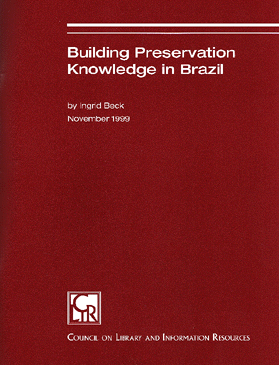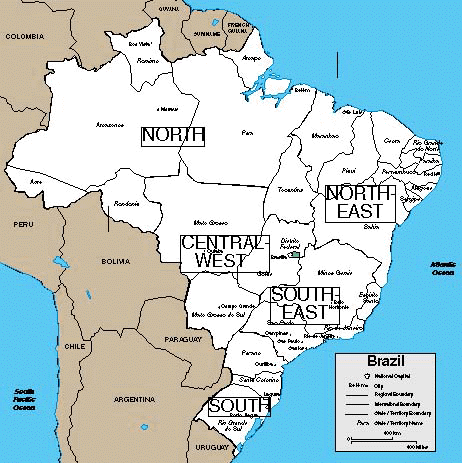Building Preservation Knowledge in Brazil

by Ingrid Beck
November 1999
Copyright 1999 by the Council on Library and Information Resources. No part of this publication may be reproduced or transcribed in any form without permission of the publisher. Requests for reproduction should be submitted to the Director of Communications at the Council on Library and Information Resources.
- Origins
- Organization and Funding
- Objectives
- Brief Chronology
- Results
The Blueprint, Phase One: 1996-1997
- Documentation in Portuguese
- Selection
- Translation
- Publication
- Distribution
- Second Edition
- Institutional Database
- Survey Design
- Mailing List
- Survey Results
- Database
- Core Workshops
- Multiplier Effect
- Workshop Content
- Number of Workshops and Participants
- Location and Schedule
- Selection and Invitation of Participants
- Instructors
- Teaching Materials
- Videos
- Participant Evaluation
- Regional Workshops
The Blueprint, Phase Two: 1998-1999
- First Annual Working Group Meeting
- New Survey
- Web Site Launch
- New Workshops
- New Publications
Lessons Learned and Recommendations
Appendix II: Institutional Database Questionnaire
Appendix III: Collaborative Institutions and Workgroup Members
About the Author
Ingrid Beck is director of preservation at the National Archives of Brazil and coordinator of the Preventive Conservation in Libraries and Archives Project.
She began her career in the National Museum of Fine Arts, where she created the Section of Arts on Paper Conservation. She has a degree in museum science from the Federal University of Rio de Janeiro, and obtained a certificate of specialization in the conservation of documents and graphic arts from the Library of the University of Göttingen and from the State Graphic Collection of the State of Bavaria, in Munich.
Ms. Beck is president of the National Council of Archives’ Technical Chamber of Conservation of Documents. She is also a member of the Inter-American Committee of Conservation Centers of the Organization of American States and has served as a regular member of the Committee on Conservation and Restoration of the International Council of Archives.
Acknowledgments
This project would not be possible without the dedication and cooperation of many people and organizations, in Brazil and abroad. I would like to thank all who have been part of it, especially members of the work group listed in Appendix III.
I am grateful to the general director of the National Archives, Jaime Antunes da Silva, who allowed me to devote time to the considerable work that this project demanded. This was possible only because of the cooperation of the National Archives’ preservation staff, who ensured that everything continued to work smoothly.
From the project’s conception to its planning and execution, special thanks go to my colleague Solange Zúñiga.
Hans Rütimann, director of international developments at CLIR, was our partner and mentor. He was generous with his encouragement and help at every stage of the project.
I would like to thank The Andrew W. Mellon Foundation for providing significant funding, as well as Richard Ekman, secretary of the foundation, whose suport of the project was unwavering. At Vitae, a Brazilian nonprofit organization that has funded numerous projects in the preservation of cultural heritage, I would especially like to thank Gina Machado for her wonderful personal support and encouragement.
Finally, I would like to thank Kathlin Smith at CLIR and Suzanne Snell Tesh for their cooperation in producing this report.
Ingrid Beck
November 1999
Foreword
This report tells a story. It started with a modest requestto help support the translation of important preservation literature into Portuguese. Approval of the request by The Andrew W. Mellon Foundation was like the proverbial pebble thrown into a quiet lake, with concentric circles expanding. On the basis of the translations, workshops were organized and thousands of libraries and archives were contacted with questions about collections and efforts to preserve them. Eventually, the project educated hundreds of people in all aspects of preservation and culminated in the receipt of the Brazilian government’s most prestigious cultural heritage award for 1998.
In July 1997, I was invited to attend one of the workshops, in São Paulo, with a total of about 30 participants. It was gratifying to watch the participants receive the large package containing preservation literature and manuals in Portuguese, and to witness the ensuing enthusiastic discussion. After that workshop, I had no doubt about the project’s wide reach and effectiveness, and this was confirmed by a follow-up visit to Rio de Janeiro in October of 1998. For an entire day I listened to reports from the regional coordinatorsindividuals who had attended one of the core workshops and carried the course materials, the knowledge, and the renewed dedication to far-flung regions of the country. All participants reported with pride on their accomplishments and on how they rallied local support and adapted the course materials to local needs. A sense of good-natured competition made for a lively show-and-tell.
The concentric circles expanded far beyond Brazil and reached Portuguese-speaking countries in Africa, where the translations, support, and advice helped institutions embark on their own preservation training and education.
We are often asked, “How can preservation awareness be raised in a country?” This report provides one answer. After more than 10 years of working with libraries and archives around the world, we are aware that what works in one country does not necessarily work in another. This report, therefore, is not an exact blueprint for applying in another country the methodologies, strategies, and organization chosen by our Brazilian colleagues. What can be applied is the basic concept that led to success in Brazil: complete dedication and hard work by a group of individuals, the careful selection of regional coordinators who continue and enlarge the work locally and regionally, and steady support and contact to assure these regional coordinators that their efforts contribute to a national, and even international, effort.
Ingrid Beck, who deserves the major credit for this success story, wrote the following account at our request. We are very grateful that she accepted the assignment in spite of her continued work on administering the still-growing project. Muito obrigado, Ingrid!
Hans Rütimann
Director, International Developments
Figure 1. Map of Brazil

Straddling the equator, Brazil encompasses 3.3 million square miles of territory, stretching roughly 2,000 miles from north to south and about the same distance from east to west. Most of the country lies in the tropics of the Southern Hemisphere, where average temperatures exceed 20 degrees Celsius and there are two seasons, the rainy and the dry. The country’s north and northeast regions lie squarely in the tropical zone and contain the Amazonian rain forest, fertile coastal plantations where cash crops are grown, beaches, and the arid inland sertão.
Brazil’s central plain, known as the Central-west, is an elevated plateau covered with forest and woodland that is gradually being transformed into farmland and ranches. This temperate plateau extends almost to the coast in the country’s southern and southeastern regions, where about two-thirds of Brazil’s people live on about 20 percent of its richest land. The Southeast is home to Brazil’s three largest cities Rio de Janeiro on the tropical coast, and São Paulo and Belo Horizonte on the temperate plateau and to most of its industry and trade, including rich mining production. Most food crops and livestock are raised in the South, which also has a temperate climate.
